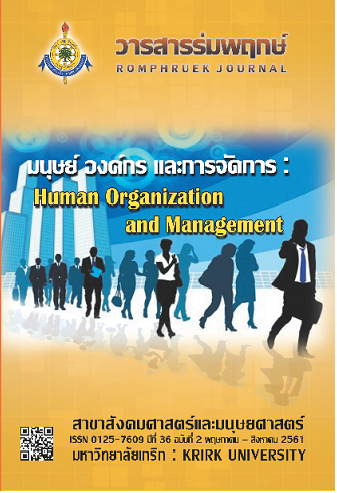Common-pool Resource Management : Theoretical Approach and Application
Main Article Content
Abstract
Common-pool resources are defined as non-private property. These resources – such as rivers, forests, etc., - are collectively utilized by villagers. There are three mainstream approaches – these are,the tragedy of the commons, the prisoner’s dilemma game, and the logic of collective action – opposing against the common-pool resources managed by the villagers. However, Elinor Ostrom has insisted that villagers can manage common-pool resource under conditions of the state’s acceptance of community rights to local resource management, villagers’ participations, rules and regulations of utilization and maintenance, sanctions of offenders, effective conflict management, and linkage to networks.
Article Details
Every article published in the Romphruek Journal of the Humanities and Social Sciences is the opinion and point of view of the authors. Thery're not the viewpoint of Krirk University or the editored department. Any part or all of the articles for pablication must be clearly cited.
References
ปรีดา วานิชภูมิ. (2556). ความสำเร็จของการจัดการภาคีสาธารณะในกรณีของป่าชุมชน จังหวัดระยอง. ดุษฎีนิพนธ์รัฐประศาสนศาสตรดุษฎีบัณฑิต คณะศิลปะศาสตร์ มหาวิทยาลัยเกริก.
สุจิตรา สามัคคีธรรม. (2559). เศรษฐศาสตร์การเมืองว่าด้วยเครือข่ายป่าชุมชนในเขตรอยต่อ 5 จังหวัดภาคตะวันออก. ดุษฎีนิพนธ์ หลักสูตรรัฐศาสตรดุษฎีบัณฑิต สาขาวิชาเศรษฐศาสตร์การเมืองและการบริหารจัดการ คณะรัฐศาสตร์และนิติศาสตร์ มหาวิทยาลัยบูรพา.
สมศักดิ์ สามัคคีธรรม. (2558). การจัดการภาคีสาธารณะแบบใหม่ในกรณีของป่าชุมชนภาคตะวันออก. รายงานผลการวิจัย คณะพัฒนาสังคมและสิ่งแวดล้อม สถาบันบัณฑิตพัฒนบริหารศาสตร์.
สมศักดิ์ สามัคคีธรรม. (2559) การจัดการทรัพยากรร่วมตามแนวทางเศรษฐกิจพอเพียง: ศึกษากรณีป่าชุมชนในภาคตะวันออก, รายงานผลการวิจัย ศูนย์ศึกษาปรัชญาของเศรษฐกิจพอเพียงกับการพัฒนาที่ยั่งยืน, สถาบันบัณฑิตพัฒนบริหารศาสตร์.
สำนักจัดการป่าชุมชน. (2560) ข้อมูลเกี่ยวกับป่าชุมชน 2560, สำนักจัดการป่าชุมชน กรมป่าไม้.
อภิชัย พันธเสน. (2539). การพัฒนาชนบทไทย: สมุทัยและมรรคตอนที่ 3: ความหวัง ทางออก และทางเลือกใหม่.
กรุงเทพฯ: มูลนิธิภูมิปัญญา.
อภิชัย พันธเสน. (2545). ทำอย่างไรจึงจะได้ป่าและพื้นที่สีเขียวคืนมา. กรุงเทพฯ: สำนักพิมพ์มหาวิทยาลัยธรรมศาสตร์.
Achua, C. F. &Lussier, R. N. (2013). Effective Leadership. South-Western: Cengage Learning.
Aligica, P. D. & Tarko, V. (2013) ‘Co-Production, Polycentricity, and Value Heterogeneity: The Ostrom’s Public Choice Institutionalism Revisited’, The American Political Science Review, Vol. 107, No. 4
Blau, P. M. (1964). Exchange and Power in Social Life. New York: Wiley.
Hardin, G. (1968) ‘The Tragedy of the Commons’, Science, Vol. 162, pp.1243-1248.
Kotter, J. P. (1996) Leading Change, Boston: Harvard Business School Press.
McGinnis, M. D. & Ostrom, E. (2011) ‘Reflections on Vincent Ostrom, Public Administration, and Polycentricity’, Public Administration Review, Vol. 72, Iss. 1.
Olsen, M (1965) The Logic of Collective Action: Public Goods and the Theory of Group, Cambridge,
Mass.: Harvard University Press.
Osborne, S. P. (2010). ‘Introduction: The (New) Public Governance: A Suitable Case for Treatment?’. in Osborne, S. P. (ed.). The New Public Governance?: Emerging Perspectives on the Theory and Practice of Public Governance. London: Routledge.
Ostrom, E. (1994). Governing the Commons: The Evolution of Institutions for Collective Action. Cambridge: Cambridge University.
Ostrom, E. (2010). ‘Beyond Markets and States: Polycentric Governance of Complex Economic Systems’. American Economic Review. Vol. 100, June.
Ostrom, V.; Tiebout, C. M. & Warren, R. (1961) ‘The Organization of Government in Metropolitan Areas: A Theoretical Inquiry’, American Political and Social Science Review, Vol. 55, No. 4.
Putnam, R. D. (2002). Democracies in Flux: The Evolution of Social Capital in Contemporary Society. Oxford: Oxford University Press.
Sarker, A.; Ikeda, T.; Abe, T. & Inoue, K. (2015) ‘Design Principles for Managing Coastal Fisheries Commons in Present-Day Japan’, Ecological Economics, Vol. 117, pp.32-38.
Toonen, T. (2010) ‘Resilience in Public Administration: The Work of Elinor and Vincent Ostrom, from a Public Administration Perspective’, Public Administration Review, March and April

